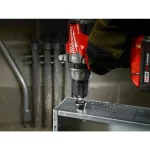Introduction
When it comes to drilling, having the right tools for the job is essential. Two commonly used drill bits are the tile drill bit and the regular drill bit. While they may seem similar, there are important differences between the two that make each one suitable for specific applications. In this article, we will explore these differences and understand when to use a tile drill bit and when to use a regular drill bit.
1. Composition and Design
The first major difference between a tile drill bit and a regular drill bit lies in their composition and design.
A regular drill bit is typically made of high-speed steel (HSS) or cobalt steel. HSS drill bits are versatile and can be used for various materials such as wood, plastic, and metal. Cobalt steel drill bits, on the other hand, are more durable and heat-resistant, making them ideal for hard metals.
On the contrary, a tile drill bit is specifically designed for drilling into tiles, ceramics, porcelain, and glass. It consists of a carbide tip or diamond coating for increased hardness and abrasion resistance. The carbide or diamond tip allows the tile drill bit to create clean, precise holes without cracking or damaging the delicate surface of the material.
2. Cutting Technique
The second difference between a tile drill bit and a regular drill bit lies in their cutting techniques.
A regular drill bit typically uses a twisting motion to penetrate the material. The flutes on the bit help remove the chips and debris from the hole as it drills through. This cutting technique works well for softer materials like wood and plastic, but it can be challenging to achieve clean, chip-free holes in harder materials like ceramic and glass.
A tile drill bit, on the other hand, employs a different cutting technique. The carbide or diamond tip of the drill bit grinds through the tile rather than chipping it away. This grinding action reduces the risk of cracking or damaging the tile surface, resulting in clean and precise holes.
3. Cooling and Lubrication
The third difference between a tile drill bit and a regular drill bit is the requirement for cooling and lubrication.
Regular drill bits, especially when used on metal, often require lubrication to reduce friction and heat. This can be achieved by using cutting oil or coolant. Without proper lubrication, the drill bit can overheat, become dull, and wear out prematurely.
Tile drill bits, on the other hand, do not require lubrication during the drilling process. However, they do require cooling to prevent overheating. This is typically done by using water as a coolant. The water cools down the tile and the drill bit, reducing the risk of cracking due to excessive heat.
Conclusion
In summary, the difference between a tile drill bit and a regular drill bit lies in their composition, design, cutting techniques, and cooling requirements. A tile drill bit is specifically designed for drilling into tiles and delicate materials like ceramics and glass. It has a carbide tip or a diamond coating for increased hardness and abrasion resistance. The cutting technique involves grinding instead of chipping to create clean and precise holes. Tile drill bits also require cooling with water to prevent overheating. On the other hand, regular drill bits are suitable for a wide range of materials and employ a twisting motion with flutes to remove chips and debris from the hole. They may require lubrication to reduce friction and heat when used on harder materials. Understanding these differences allows us to choose the right drill bit for our specific drilling needs.
.webp)
